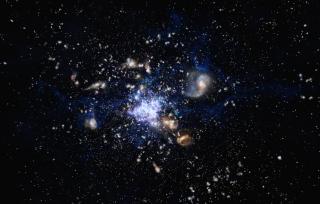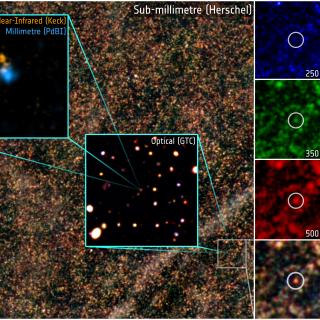Bibcode
Bakx, Tom J. L. C.; Berta, S.; Dannerbauer, H.; Cox, P.; Butler, K. M.; Hagimoto, M.; Hughes, D. H.; Riechers, D. A.; van der Werf, P. P.; Yang, C.; Baker, A. J.; Beelen, A.; Bendo, G. J.; Borsato, E.; Buat, V.; Cooray, A. R.; Dunne, L.; Dye, S.; Eales, S.; Gavazzi, R.; Harris, A. I.; Ismail, D.; Ivison, R. J.; Jones, B.; Krips, M.; Lehnert, M. D.; Marchetti, L.; Messias, H.; Negrello, M.; Neri, R.; Omont, A.; Perez-Fournon, I.; Nanni, A.; Chartab, N.; Serjeant, S.; Stanley, F.; Tamura, Y.; Urquhart, S. A.; Vlahakis, C.; Weiß, A.; Young, A. J.
Referencia bibliográfica
Monthly Notices of the Royal Astronomical Society
Fecha de publicación:
6
2024
Número de citas
5
Número de citas referidas
3
Descripción
We report on deep SCUBA-2 observations at 850 $\mu$m and NOrthern Extended Millimetre Array (NOEMA) spectroscopic measurements at 2 mm of the environment surrounding the luminous, massive (M* ≈ 2 × 1011 M⊙) Herschel-selected source HerBS-70. This source was revealed by previous NOEMA observations to be a binary system of dusty star-forming galaxies at z = 2.3, with the east component (HerBS-70E) hosting an active galactic nucleus. The SCUBA-2 observations detected, in addition to the binary system, 21 sources at >3.5σ over an area of ~25 square comoving Mpc with a sensitivity of 1σ850 = 0.75 mJy. The surface density of continuum sources around HerBS-70 is three times higher than for field galaxies. The NOEMA spectroscopic measurements confirm the protocluster membership of three of the nine brightest sources through their CO(4-3) line emission, yielding a volume density 36 times higher than for field galaxies. All five confirmed sub-mm galaxies in the HerBS-70 system have relatively short gas depletion times (80-500 Myr), indicating the onset of quenching for this protocluster core due to the depletion of gas. The dark matter halo mass of the HerBS-70 system is estimated around 5 × 1013 M⊙, with a projected current-day mass of 1015 M⊙, similar to the local Virgo and Coma clusters. These observations support the claim that DSFGs, in particular the ones with observed multiplicity, can trace cosmic overdensities.
Proyectos relacionados

Gas Molecular y Polvo en Galacias através del Tiempo Cósmico
Dos cuestiones fundamentales en la Astrofísica son la conversión de gas molecuar en estrellas y cómo este proceso físico depende del entorno en todas las escalas, desde sistemas planetarios, cúmulos estelares, galaxias hasta cúmulos de galaxias. El objectivo principal de este proyecto es el de estudiar la formación y evolución de galaxias a partir
Helmut
Dannerbauer

Formación y Evolución de Galaxias: Observaciones Infrarrojas y en otras Longitudes de Onda
Este grupo desarrolla varios proyectos extragalácticos en diferentes rangos del espectro electromagnético utilizando satélites y telescopios en tierra para estudiar la evolución cosmológica de las galaxias y el origen de la actividad nuclear en galaxias activas. En el aspecto instrumental, el grupo forma parte del consorcio internacional que ha
Ismael
Pérez Fournon